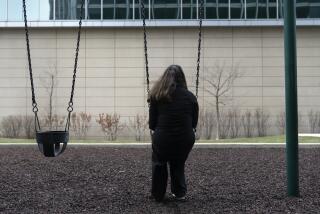White and mixed-race youths rank high in alcohol, substance abuse
- Share via
The first-ever survey of adolescent alcohol and drug abuse to recognize youths of mixed race or ethnicity has found that such kids hover closest to white adolescents in the rate at which they suffer substance abuse disorders. That is not reassuring, because white adolescents are among the most likely ethnic and racial groups to have substance-use disorders.
Of all ethnic groups, Native Americans were found to suffer the highest rates of drug and alcohol abuse and dependence -- about 15% in a given year. African American adolescents were among the least likely to abuse or be dependent on drugs or alcohol: on a yearly basis, roughly 5% of black teens fit the criteria for substance-use disorder - -almost as low a rate as prevails among adolescents of Asian or Pacific Islander ethnicity (3.5%).
Latino youths -- the fastest-growing ethnic group in this age cohort -- fell below white and multi-ethnic adolescents in their rate of substance-use disorders, but not by much: 7.7% qualified as having dangerously abused or been dependent on drugs or alcohol in the past year.
The survey was published Monday in the Archives of General Psychiatry. Between 2005 and 2007, researchers plumbed the drug and alcohol use patterns of 72,561 adolescents between age 12 and 17. They conducted computer-assisted interviews with adolescents about their use in the past 12 months of alcohol and a wide range of illicit drugs, including marijuana, cocaine and opioid painkillers taken for non-medical reasons.
And where such use was reported, they probed for indications that an adolescent’s drug or alcohol consumption rose to the level of substance use disorder: that it interfered with his or her relationships or obligations, that it had resulted in a brush with law enforcement, that the child took hazardous risks under the influence, that the youth’s substance use was accelerating or that efforts to cut back had failed or produced signs of physical withdrawal.
Adolescents who identified themselves as mixed race or ethnicity were more likely than any other group to exhibit signs of problematic drug and alcohol use: 3.5% appeared to have substance-use disorders in both categories, compared with 3.1% of Native Americans, 2.3% of whites and 2.3% of Latinos. Among African Americans and Asians, signs of substance-use disorders were rare, totaling 0.9% and 0.6%, respectively. This sign of risk-taking among adolescents who identify as multi-ethnic runs counter to other studies of this population.
Kids who identified themselves as multi-racial or multi-ethnic were more likely than white kids to have used opioid painkillers, marijuana, inhalants, cocaine and hallucinogens in the year before being surveyed. In hallucinogen use, the multi-ethnic teens were roughly on a par with Native American youths: 4.6% and 4.5% acknowledged taking hallucinogens in the preceding 12 months.
Overall, the study reinforced growing concerns among public health officials about the resurgence of marijuana use among teens, and about the penetration of opioid painkiller abuse into this young generation of users. More than one in four adolescents who acknowledged marijuana use in the past year was thought to be dependent or use marijuana in a dangerous fashion. And opioid painkillers were the second most frequently abused drug among adolescents. Rates of past-year use ranged from 4% among Asians and Pacific Islanders to 9.7% among Native Americans.
More to Read
Sign up for Essential California
The most important California stories and recommendations in your inbox every morning.
You may occasionally receive promotional content from the Los Angeles Times.











